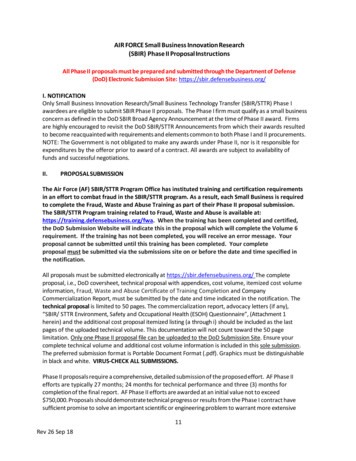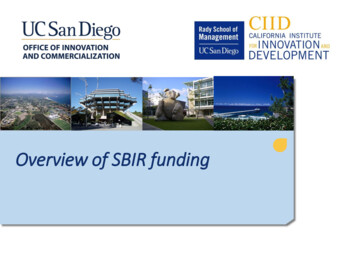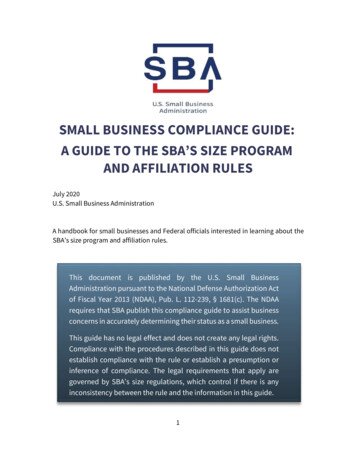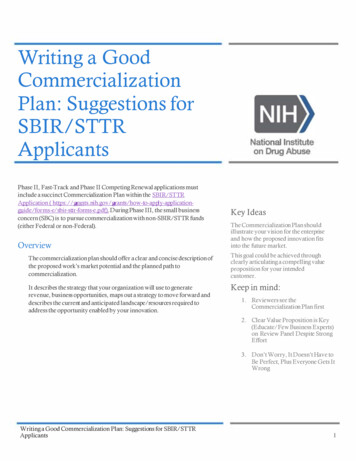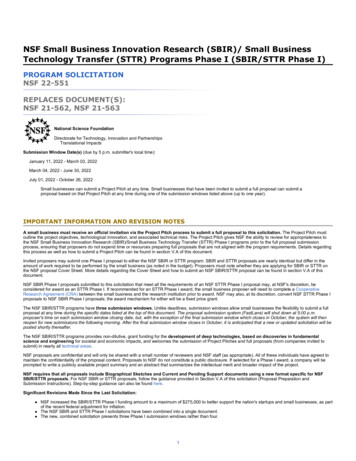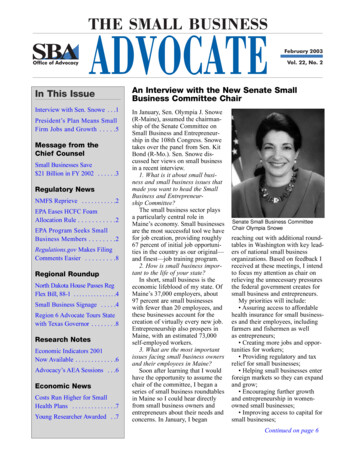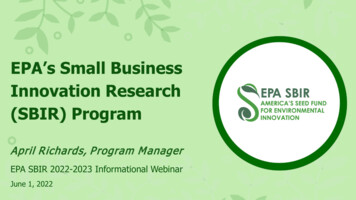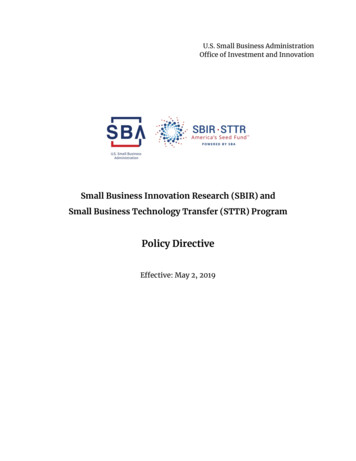
Transcription
U.S. Small Business AdministrationOffice of Investment and InnovationSmall Business Innovation Research (SBIR) andSmall Business Technology Transfer (STTR) ProgramPolicy DirectiveEffective: May 2, 2019
Table of Contents1.Purpose . 512.Summary of Statutory Provisions . 533.Definitions . 564.Phased Structure of Programs . 675.Program Solicitation Process . 816.Eligibility and Application (Proposal) Requirements . 837.Program Funding Process . 918.Terms of Agreement Under SBIR/STTR Awards . 1019.Responsibilities of SBIR/STTR Agencies and Departments . 11110. Reporting Requirements for Participating Agencies, Applicants and Awardees. 13011. Responsibilities of SBA . 15012. Supporting Programs and Initiatives . 153
1. Purpose(a) Sections 9(j) and 9(p) of the Small Business Act (the Act) require that the SmallBusiness Administration (SBA) issue Policy Directives for the general conduct of theSBIR and STTR programs within the Federal Government.(b) This Policy Directive fulfills SBA's statutory obligation to provide guidance to theparticipating Federal agencies for the general operation of the SBIR and STTR programs.Because most of the policy for the SBIR and STTR program is the same, SBA issues asingle Policy Directive for both programs. Unless one of the programs is specificallymentioned, the term “program” or “programs” refers to both the SBIR and STTRprograms. In addition, “SBIR/STTR” is used throughout to refer to both programs.(1) The following sections pertain only to the STTR program: § 3(cc) - Definition of“Research Institution,” § 7(k) - Management of the STTR Project, § 8(c) - Allocationof Intellectual Property Rights in STTR Award, and § 12(e) - Phase 0 Proof ofConcept Partnership Pilot Program.(2) The following sections pertain only to the SBIR program: § 3(b) - Definition of“Additionally Eligible State,” § 3(l) - Definition of “Covered Small Business,”§ 4(b)(1)(ii) – Direct to Phase II Awards, § 6(a)(6) – Majority-Owned by MultipleVCOCs, Hedge Funds or Private Equity Firms, § 6(b)(1)(iii) – Registration andCertifications for Proposal and Award for Majority-Owned by Multiple VCOCs,Hedge Funds or Private Equity Firms, and Appendix I - Certifications for Proposaland Award for Majority-Owned by Multiple VCOCs, Hedge Funds or Private EquityFirms.(3) Additional or modified instructions may be issued by SBA as a result of public51
comment or experience. With this directive, SBA fulfills the statutory requirement tosimplify and standardize the program proposal, selection, contracting, compliance,and audit procedures for the programs to the extent practicable, while allowing theParticipating Agencies flexibility in the operation of their individual programs.Wherever possible, SBA has attempted to reduce the paperwork and regulatorycompliance burden on small business concerns (SBCs) applying to and participatingin the SBIR/STTR programs, while still meeting the statutory reporting and datacollection requirements.(c) The statutory purpose of the SBIR program is to strengthen the role of innovativeSBCs in Federally-funded research or research and development (R/R&D). Specificprogram purposes are to: (1) stimulate technological innovation; (2) use small businessto meet Federal R/R&D needs; (3) foster and encourage participation by socially andeconomically disadvantaged SBCs (SDBs), and by women-owned SBCs (WOSBs), intechnological innovation; and, (4) increase private sector commercialization ofinnovations derived from Federal R/R&D, thereby increasing competition, productivityand economic growth.(d) In addition to the broad goals of the SBIR program, the statutory purpose of the STTRprogram is to stimulate a partnership of ideas and technologies between innovative SBCsand non-profit Research Institutions. By providing awards to SBCs for cooperativeR/R&D efforts with Research Institutions, the STTR program assists the U.S. smallbusiness and research communities by supporting the commercialization of innovativetechnologies.(e) Federal agencies participating in the programs (Participating Agencies) are obligated52
to follow the guidance provided by this Policy Directive. Each Participating Agency isrequired to review its rules, policies, and guidance on the programs to ensure consistencywith this Policy Directive and to make any necessary changes in accordance with eachagency's normal procedures. This is consistent with the statutory authority provided toSBA concerning the SBIR/STTR programs.2. Summary of Statutory Provisions(a) The SBIR program is codified at § 9 of the Act, 15 U.S.C. 638. The SBIR program isauthorized until September 30, 2022, or as otherwise provided in law subsequent to thatdate.(b) Each Federal agency with an extramural budget for R/R&D in excess of 100,000,000 must participate in the SBIR program and spend (obligate) a minimumpercentage of their extramural R/R&D budgets (obligations) of not less than 3.2% of suchbudget in fiscal year 2017 and for the percentage required by statute for each fiscal yearafter for awards to SBCs for R/R&D under the SBIR program.A Federal agency may exceed this minimum percentage.(c) The STTR program is also codified at § 9 of the Act, 15 U.S.C. 638. The STTRprogram is authorized until September 30, 2022, or as otherwise provided in lawsubsequent to that date.(d) Each Federal agency with an extramural budget for R/R&D in excess of 1,000,000,000 must participate in the STTR program and spend (obligate) a minimumpercentage of their extramural R/R&D budgets (obligations) of not less than 0.45% ofsuch budget in fiscal year 2016 and for the percentage required by statute for each fiscalyear after on awards to SBCs under the STTR program.53
A Federal agency may exceed this minimum percentage.(e) In general, each Participating Agency must make SBIR/STTR awards for R/R&Dthrough the following uniform, three-phase process:(1) Phase I awards to determine, insofar as possible, the scientific and technical meritand feasibility of ideas that appear to have commercial potential.(2) Phase II awards to further develop work from Phase I that meets particularprogram needs and exhibits potential for commercial application.(3) Phase III awards where commercial applications of SBIR/STTR program-fundedR/R&D are funded by non-Federal sources of capital; or where products, services orfurther research intended for use by the Federal Government are funded by nonSBIR/STTR sources of Federal funding.(f) Participating Agencies must report to SBA on the calculation of the agency’sextramural R/R&D budget, for the purpose of determining SBIR/STTR program funding,within four months of enactment of each agency’s annual Appropriations Act.(g) The Act explains that agencies are authorized and directed to cooperate with SBA inorder to carry out and accomplish the purpose of the programs. As a result, eachParticipating Agency shall provide information to SBA for SBA to monitor and analyzeeach agency’s SBIR/STTR program and to report annually to the Committee on SmallBusiness and Entrepreneurship of the Senate and to the Committee on Small Businessand the Committee on Science, Space, and Technology of the House of Representatives.For more information on the agency’s reporting requirements, including the frequency forspecific reporting requirements, see § 10 of the Policy Directive.(h) SBA establishes databases and websites to collect and maintain, in a common format,54
information that is necessary to assist SBCs and assess the SBIR/STTR programs.(i) SBA implements the Federal and State Technology (FAST) Partnership Program tostrengthen the technological competitiveness of SBCs, to the extent that FAST isauthorized by law.(j) The competition requirements of the Armed Services Procurement Act of 1947 (10U.S.C. 2302, et seq.) and the Federal Property and Administrative Services Act of 1949(41 U.S.C. 3101, et seq.) must be read in conjunction with the procurement noticepublication requirements of § 8(e) of the Act (15 U.S.C. 637(e)). The following noticepublication requirements of § 8(e) of the Act apply to SBIR/STTR Participating Agenciesusing contracts as a SBIR or STTR Funding Agreement.(1) Any federal executive agency intending to solicit a proposal to contract forproperty or services valued above the amounts set forth in Federal AcquisitionRegulations (FAR) § 5.101, must transmit a notice of the impending solicitation tothe Government wide point of entry (GPE) for access by interested sources. See FAR§ 5.201. The GPE, located at www.fbo.gov, is the single point where Governmentbusiness opportunities, including synopses of proposed contract actions, solicitations,and associated information, can be accessed electronically by the public. In addition,an agency must not issue its solicitation for at least 15 days from the date of thepublication of the GPE. The agency must establish a deadline for submission ofproposals in response to a solicitation in accordance with FAR § 5.203.(2) The contracting officer must generally make available through the GPE thosesolicitations synopsized through the GPE, including specifications and other pertinentinformation determined necessary by the contracting officer. See FAR § 5.102.55
(3) Any executive agency awarding a contract for property or services must synopsizethe award through the GPE in accordance with FAR subpart 5.3.(4) The following are exemptions from the notice publication requirements:(i) In the case of agencies intending to solicit Phase I proposals for contracts inexcess of 25,000, the head of the agency may exempt a particular solicitationfrom the notice publication requirements if that official makes a writtendetermination, after consulting with the Administrator of the Office of FederalProcurement Policy (OFPP) and the SBA Administrator, that it is inappropriate orunreasonable to publish a notice before issuing a solicitation.(ii) The SBIR/STTR Phase II award process.(iii) The SBIR/STTR Phase III award process.3. Definitions(a) Act. The Small Business Act (15 U.S.C. 631, et seq.), as amended.(b) Additionally Eligible State. (SBIR only) A State in which the total value of fundingagreements awarded to SBCs under all agency SBIR programs is less than the total valueof funding agreements awarded to SBCs in a majority of other States, as determined bySBA's Administrator in biennial fiscal years and based on the most recent statisticscompiled by the Administrator.(c) Affiliate. This term has the same meaning as set forth in 13 CFR part 121—SmallBusiness Size Regulations, § 121.103, “How Does SBA Determine Affiliation?”. Furtherinformation about SBA’s affiliation rules and a guide on affiliation is available atwww.SBIR.gov and www.SBA.gov/size.(d) Applicant. The organizational entity that qualifies as an SBC at all pertinent times56
and that submits a contract proposal or a grant application for a funding agreement underthe SBIR/STTR programs.(e) Awardee. The organizational entity that receives an SBIR or STTR Phase I, Phase II,or Phase III award. An “SBIR/STTR Awardee.”(f) Commercialization. The process of developing products, processes, technologies, orservices and the production and delivery (whether by the originating party or others) ofthe products, processes, technologies, or services for sale to or use by the FederalGovernment or commercial markets.(g) Computer Database. A collection of data recorded in a form capable of beingprocessed by a computer. The term does not include Computer Software.(h) Computer Programs. A set of instructions, rules, or routines recorded in a form that iscapable of causing a computer to perform a specific operation or series of operations.(i) Computer Software. Computer Programs, source code, source code listings, objectcode listings, design details, algorithms, processes, flow charts, formulae, and relatedmaterial that would enable the software to be reproduced, recreated, or recompiled.Computer Software does not include Computer Databases or Computer SoftwareDocumentation.(j) Computer Software Documentation. Owner's manuals, user's manuals, installationinstructions, operating instructions, and other similar items, regardless of storagemedium, that explain the capabilities of the Computer Software or provide instructionsfor using the software.(k) Covered Small Business Concern. (SBIR only) A small business concern that: (1)was not majority-owned by multiple venture capital operating companies (VCOCs),57
hedge funds, or private equity firms on the date on which it submitted an application inresponse to a solicitation under the SBIR program; and (2) is majority-owned by multipleventure capital operating companies, hedge funds, or private equity firms on the date ofthe SBIR award.(l) Data. All recorded information, regardless of the form or method of recording or themedia on which it may be recorded. The term does not include information incidental tocontract or grant administration, such as financial, administrative, cost or pricing ormanagement information.(m) Essentially Equivalent Work. Work that is substantially the same research, which isproposed for funding in more than one contract proposal or grant application submitted tothe same Federal Agency, or submitted to two or more different Federal Agencies forreview and funding consideration; or work where a specific research objective and theresearch design for accomplishing the objective are the same or closely related to anotherproposal or award, regardless of the funding source.(n) Extramural R/R&D Budget/Obligations. The sum of the total obligations for R/R&Dminus amounts obligated during a given fiscal year for R/R&D activities by employees ofa Federal Agency in or through Government-owned, Government-operated facilities. Forthe Agency for International Development, the “extramural budget” does not includeamounts obligated solely for general institutional support of international research centersor for grants to foreign countries. For the Department of Energy, the “extramural budget”does not include amounts obligated for atomic energy defense programs solely forweapons activities or for naval reactor programs. (See also § 7(j) of this Policy Directivefor additional exemptions related to national security.)58
(o) Federal Agency. An executive agency as defined in 5 U.S.C. 105, and a militarydepartment as defined in 5 U.S.C. 102 (Department of the Army, Department of theNavy, Department of the Air Force), except that it does not include any agency within theIntelligence Community as defined in Executive Order 12333, § 3.4(f), or its successororders.(p) Federal Laboratory. As defined in 15 U.S.C. 3703, means any laboratory, anyfederally funded research and development center, or any center established under 15U.S.C. 3705 and 3707 that is owned, leased, or otherwise used by a Federal Agency andfunded by the Federal Government, whether operated by the Government or by acontractor.(q) Form, Fit, and Function Data. Data relating to items, components, or processes thatare sufficient to enable physical and functional interchangeability, and data identifyingsource, size, configuration, mating and attachment characteristics, functionalcharacteristics, and performance requirements. For Computer Software it means dataidentifying source, functional characteristics, and performance requirements, butspecifically excludes the source code, algorithms, processes, formulas, and flow charts ofthe software.(r) Funding Agreement. Any contract, grant, or cooperative agreement entered intobetween any Federal Agency and any SBC for the performance of experimental,developmental, or research work, including products or services, funded in whole or inpart by the Federal Government.(s) Government Purpose. Any activity in which the United States Government is a party,including cooperative agreements with international or multi-national defense59
organizations or sales or transfers by the United States Government to foreigngovernments or international organizations. Government purposes include competitiveprocurement, but do not include the rights to use, modify, reproduce, release, perform,display, or disclose Technical Data or Computer Software for commercial purposes orauthorize others to do so.(t) Innovation. Something new or improved, having marketable potential, that includesthe development of new technology, the refinement of existing technology, or thedevelopment of new applications for existing technology.(u) Intellectual Property. The separate and distinct types of intangible property that arereferred to collectively as “Intellectual Property,” including but not limited to: patents,trademarks, copyrights, trade secrets, and mask works.(v) Joint Venture. See 13 CFR 121.103(h).(w) Key Individual. The Principal Investigator/Project Manager and any other personnamed as a “key” employee in a proposal submitted in response to a ProgramSolicitation.(x) Operations, Maintenance, Installation, or Training Purposes (OMIT) Data. Data thatis necessary for operation, maintenance, installation, or training purposes (but notincluding detailed manufacturing or process data).(y) Participating Agency(ies). A federal agency with an SBIR or STTR program. An“SBIR/STTR Agency.”(z) Principal Investigator/Project Manager. The one individual designated by theApplicant to provide the scientific and technical direction to a project supported by theFunding Agreement.60
(aa) Program Solicitation. A formal solicitation for proposals issued by a Federal Agencythat notifies the small business community of its R/R&D needs and interests in broad andselected areas, as appropriate to the agency, and requests for proposals from SBCs inresponse to these needs and interests.(bb) Prototype. A product, material, object, system, or process, or a model thereof, that isin development, regardless of whether it is in tangible, electronic, graphic or other form,at any stage of development prior to its intended ultimate commercial production andsale. The term “Prototype” includes Computer Programs embedded in hardware ordevices.(cc) Research Institution. One that has a place of business located in the United States,which operates primarily within the United States or which makes a significantcontribution to the U.S. economy through payment of taxes or use of American products,materials or labor, and is: (1) A non-profit institution as defined in section 4(3) of theStevenson-Wydler Technology Innovation Act of 1980 (that is, an organization that isowned and operated exclusively for scientific or educational purposes, no part of the netearnings of which inures to the benefit of any private shareholder or individual); or (2) AFederally-funded R/R&D center (FFRDC) as identified by the National ScienceFoundation (NSF) in accordance with the Federal Acquisition Regulation issued inaccordance with section 35(c)(1) of the Office of Federal Procurement Policy Act (or anysuccessor regulation). A non-profit institution can include hospitals and militaryeducational institutions, if they meet the definition above.(dd) Research or Research and Development (R/R&D). Any activity that is: (1) asystematic study directed toward greater knowledge or understanding of the subject61
studied; (2) a systematic study directed specifically toward applying knowledge andinnovation to meet a recognized but unmet need; or (3) a systematic application ofknowledge and innovation toward the production of useful materials, devices, andsystems or methods, including design, development, and improvement of Prototypes andnew processes to meet specific requirements.(ee) SBIR/STTR Computer Software Rights. The Federal Government’s rights duringthe SBIR/STTR Protection Period in specific types of SBIR/STTR Data that areComputer Software.(1) The Federal Government may use, modify, reproduce, release, perform, display,or disclose SBIR/STTR Data that are Computer Software within the FederalGovernment. The Government may exercise SBIR/STTR Computer Software Rightswithin the Government for:(i) Use in Government computers;(ii) Modification, adaptation, or combination with other Computer Software,provided that the Data incorporated into any derivative software are subject to therights in paragraph (ee) and that the derivative software is marked as containingSBIR/STTR Data;(iii) Archive or backup; or(iv) Distribution of a computer program to another Government agency, withoutfurther permission of the Awardee, if the Awardee is notified of the distributionand the identity of the recipient prior to the distribution, and a copy of theSBIR/STTR Computer Software Rights included in the Funding Agreement isprovided to the recipient prior to the distribution. The agency in receipt of the62
distributed SBIR/STTR Data is subject to the data rights provisions in theSBIR/STTR Awardees SBIR/STTR funding agreement.(2) The Government shall not release, disclose, or permit access to SBIR/STTR Datathat is Computer Software for commercial, manufacturing, or procurement purposeswithout the written permission of the Awardee. The Government shall not release,disclose, or permit access to SBIR/STTR Data outside the Government without thewritten permission of the Awardee unless:(i) The non-Governmental entity has entered into a non-disclosure agreement withthe Government that complies with the terms for such agreements outlined in § 8of this Policy Directive; and(ii) The release or disclosure is—(A) To a Government support service contractor or their subcontractor inthe performance of a Government support services contract for internalGovernment use or activities, including evaluation, diagnosis andcorrection of deficiencies, and adaptation, combination, or integration withother Computer Software, provided that SBIR/STTR Data incorporatedinto any derivative software are subject to the rights in paragraph (ee), andprovided that the release is not for commercial purposes or manufacture;or(B) Necessary to support certain narrowly-tailored essential Governmentactivities for which law or regulation permits access of a non-Governmententity to a contractors’ data developed exclusively at private expense, nonSBIR/STTR Data, such as for emergency repair and overhaul.63
(ff) SBIR/STTR Data. All Data developed or generated in the performance of an SBIRor STTR award, including Technical Data and Computer Software developed orgenerated in the performance of an SBIR or STTR award. The term does not includeinformation incidental to contract or grant administration, such as financial,administrative, cost or pricing or management information.(gg) SBIR/STTR Data Rights. The Government’s license rights in properly markedSBIR/STTR Data during the SBIR/STTR Protection Period as follows: SBIR/STTRTechnical Data Rights in SBIR/STTR Data that are Technical Data or any other type ofData other than Computer Software and SBIR/STTR Computer Software Rights inSBIR/STTR Data that is Computer Software. Upon expiration of the protection periodfor SBIR/STTR Data, the Government has a royalty-free license to use, and to authorizeothers to use on its behalf, these Data for Government Purposes, and is relieved of alldisclosure prohibitions and assumes no liability for unauthorized use of these Data bythird parties, except that any such Data that is also protected under a subsequentSBIR/STTR award shall remain protected through the protection period of thatsubsequent award. The Government receives Unlimited Rights in all Form, Fit, andFunction Data, OMIT Data, and unmarked SBIR/STTR Data.(hh) SBIR/STTR Protection Period. The period of time during which the Government isobligated to protect SBIR/STTR Data against unauthorized use and disclosure inaccordance with SBIR/STTR Data Rights. The SBIR/STTR Protection Period begins ataward of an SBIR/STTR Funding Agreement and ends not less than twenty years fromthat date. (See § 8(b)(4) of this Policy Directive).(ii) SBIR/STTR Technical Data Rights. The Federal Government’s rights during the64
SBIR/STTR Protection Period in SBIR/STTR Data that are Technical Data or any othertype of Data other than Computer Software.(1) The Government may, use, modify, reproduce, perform, display, release, ordisclose SBIR/STTR Data that are Technical Data within the Federal Government;however, the Federal Government shall not use, release, or disclose the data forprocurement, manufacture or commercial purposes; or release or disclose theSBIR/STTR Data outside the Government except as permitted by paragraph (2)below or by written permission of the Awardee.(2) SBIR/STTR Data that are Technical Data may be released outside the FederalGovernment without any additional written permission of the Awardee only if thenon-Governmental entity or foreign government has entered into a non-disclosureagreement with the Federal Government that complies with the terms for suchagreements outlined in § 8 of this Policy Directive and the release is:(i) Necessary to support certain narrowly-tailored essential Government activitiesfor which law or regulation permits access of a non-Government entity to acontractors’ data developed exclusively at private expense, non-SBIR/STTR Data,such as for emergency repair and overhaul;(ii) To a Government support services contractor in the performance of aGovernment support services contract for internal Government use or activities,including evaluation, diagnosis or modification provided that SBIR/STTRTechnical Data incorporated into any derivative Data are subject to the rights inparagraph (ii), and the release is not for commercial purposes or manufacture;(iii) To a foreign government for purposes of information and evaluation if65
required to serve the interests of the U.S. Government; or(iv) To non-Government entities or individuals for purposes of evaluation.(jj) Small Business Concern (SBC). A concern that meets the SBIR/STTR programeligibility requirements set forth in 13 CFR 121.702, “What size and eligibility standardsare applicable to the SBIR and STTR programs?”.(kk) Socially and Economically Disadvantaged Individual. See 13 CFR 124.103 and124.104.(ll) Socially and Economically Disadvantaged SBC (SDB). See 13 CFR. part 124,subpart B.(mm) Student/Faculty-owned SBC. A small business that is majority-owned by a facultymember or a student of an institution of higher education as defined in 20 U.S.C. 1001.(nn) Subcontract. Any agreement, other than one involving an employer-employeerelationship, entered into by an Awardee of a Funding Agreement calling for supplies orservices for the performance of the original Funding Agreement.(oo) Technology Development Program.(1) the Established Program to Stimulate Competitive Research (EPSCoR) of theNational Science Foundation as established under 42 U.S.C. 1862g;(2) the Defense Established Program to Stimulate Competitive Research (DEPSCoR)of the Department of Defense;(3) the Established Program to Stimulate Competitive Research (EPSCoR) of theDepartment of Energy;(4) the Established Program to Stimulate Competitive Research (EPSCoR) of theEnvironmental Protection Agency;66
(5) the Established Program to Stimulate Competitive Research (EPSCoR) of theNational Aeronautics and Space Administration;(6) the Institutional Development Award (IDeA) Program of the National Institutes ofHealth; and(7) the Agriculture and Food Research Initiative (AFRI) of the Department ofAgriculture.(pp) Technical Data. Recorded information, regardless of the form or method of therecording, of a scientific or technical nature (including Computer SoftwareDocumentation and Computer Databases). The term does not include ComputerSoftware or financial, administrative, cost or pricing, or management information, orother data incidental to contract or grant administration. The term includes recorded Dataof a scientific or technical nature that is included in Computer Databases.(qq) United States. The 50 states, the territories and possessions of the FederalGovernment, the Commonwealth of Puerto Rico, the District of Columbia, the Republicof the Marshall Islands, the Federated States of Micronesia, and the Republic of Palau.(rr) Unlimited Rights. The Federal Government’s rights to use, modify, preparederivative works, reproduce, release, perform, display, disclose, or distribute Data inwhole or in part, in any manner and for any purpose whatsoever, and to have or authorizeothers to do so.(ss) Women-Owned SBC (WOSB). An SBC that is at least 51% owned by one or morewomen, or in the case of any publicly owned business, at least 51% of the stock is ownedby women, and women control the management and daily business operations.4. Phased Structure of Programs67
The SBIR/STTR programs employ a phased process, uniform throughout the FederalGovernment, of soliciting proposals and awarding Funding Agreements for R/R&D,production, services, or any combination, to meet stated agency needs or missions.Agencies must issue SBIR/STTR awards pursuant to competitive and merit-basedselection procedures. Agencies may not use investment of venture capital or investmentfrom hedge f
compliance burden on small business concerns (SBCs) applying to and participating in the SBIR/STTR programs, while still meeting the statutory reporting and data collection requirements. (c) The statutory purpose of the SBIR program is to strengthen the role of innovative SBCs in Federally-funded research or research and development (R/R&D).
